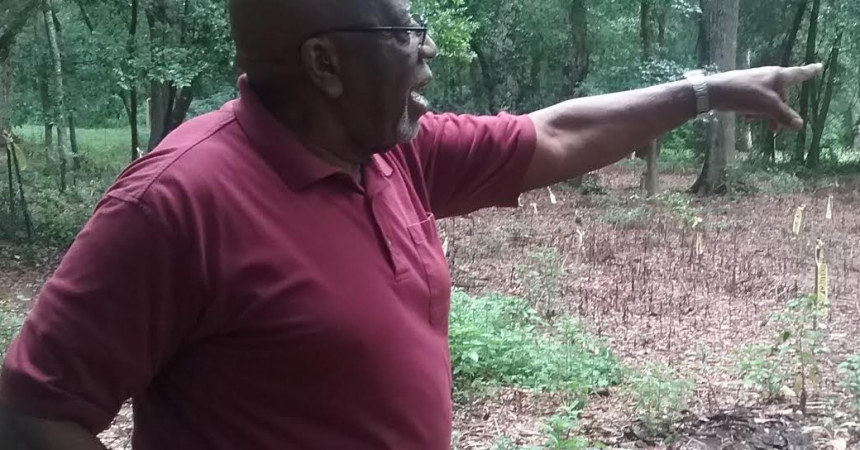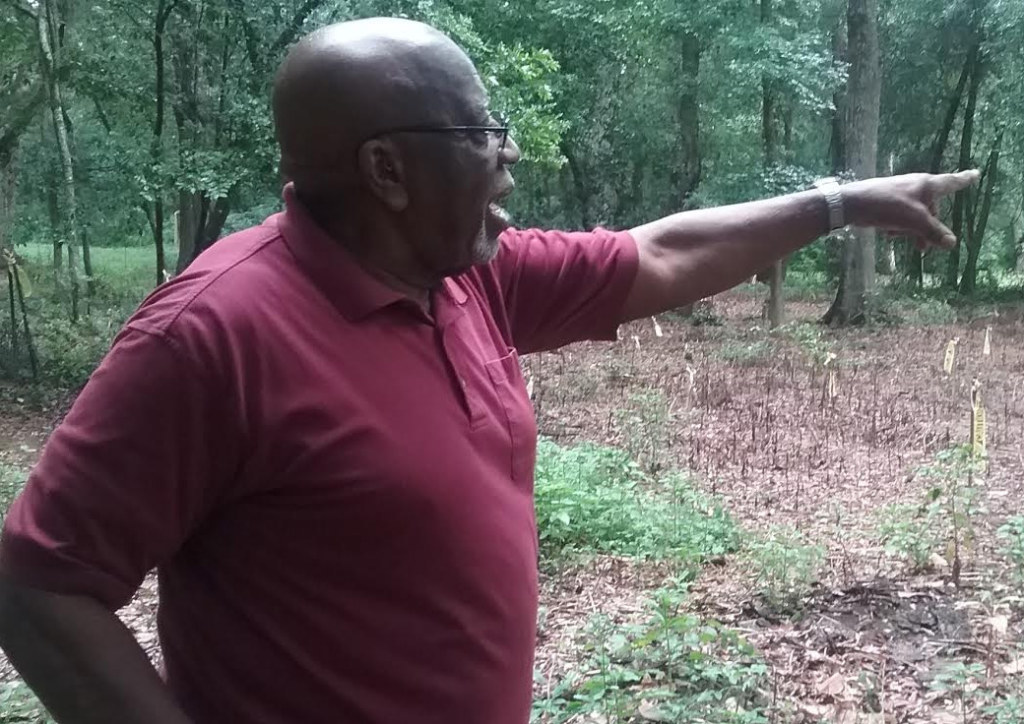
Effort underway to restore historic Black cemetery

Wilbert Ferrell is leading a community effort to restore Munree Cemetery. / Photo by St. Clair Murraine
By St. Clair Murraine
Outlook staff writer
It wasn’t until Wilbert Ferrell drove past the sign that read “Munree Cemetery Historic Landmark,” that it became clear to a visitor there was something special about a five-acre tract of land off Edenfield Road where he was about to stop.
Patches of grave headstones dotted the area, about five miles east of Tallahassee. A handful of the stones still stand upright. Some are tilted, while others are flat on the ground.
Some graves were marked by a simple piece of metal protruding from the ground.
The last burial in Munree Cemetery took place in 1946 when it was a well-kept place, said Ferrell. He and a handful of relatives and friends formed the Munree Cemetery Corporation six years ago with the mission of restoring it.
The historic significance of their mission didn’t go unnoticed by Louise Davenport, whose family owned the land as part of Fleishman Plantation. She didn’t hesitate when the corporation approached her about donating the land.
Not long after Davenport’s donation in 2011, a massive cleanup began. Crowder Excavation and Leon County government assisted with clearing out the overgrowth. An archeologist from the National Park Service conducted tests that confirmed that burials took place at the site.
Barbara Hines of the Florida Archeology Network also gave additional verification during an interview featured in a documentary by WFSU television. She confirmed that dips in the ground are what’s known as “grave slumps.”
While Drew Wise, an archeologist with the National Park Service, used a penetration radar for his proof, Hines’ team used cadaver dogs.
“Just to see the dogs sniff out graves was amazing,” said Ferrell, who estimated that more than 250 burials took place at the cemetery.
Davenport said she hasn’t seen the work done at the cemetery, expressing surprise when told of the progress.
“When I gave the land,” she said, “I had no idea it would lead to all this that it has.”
Her generosity will be on-going, Davenport said.
“I think it’s great,” she said. “I’m all for recognizing and taking care of things. It’s wonderful. There are several graves that need to be cleaned up and we will do everything we can to preserve.”
Before Davenport cleared the way for the restoration to begin six years ago, overgrown vines, tall pine and oak trees made it impossible to recognize what is believed to be one of the oldest Black cemeteries in the Big Bend. Ferrell, who heads up the Munree Cemetery Corporation, said it was built in the early 1800s.
Ferrell said the cemetery was started by owners of the Fleishman Plantation, adding that slaves are buried in most of the graves, although headstones indicate that freed Blacks were also buried there.
Some of the prominent names include Rev. Plummer Barnes, who pastored a nearby church, Ferrell said. Several of the stones also had the last name Austin etched in them.
Al Dennis, another member of the corporation, said he’s even recognized the names of some of his relatives.
“The fact that it is an African American cemetery, it’s obvious that some of our descendents are buried in that cemetery,” he said. “Who would have thought that?
“We know about the larger cemeteries on the Southside and on Old Bainbridge Road, but what about this one; the Munree cemetery and the fact that there are African American descendents who are buried there. It’s a part of our history.”
Neither of the men leading the restoration could give an estimated completion date. Much of it depends on fund raising, they said.
However, it’s clear what they’d like the cemetery to look like. They displayed a rendition created by architect Rabbani Muhammad.
“There is a lot to be done,” Dennis said. “The biggest thing now is to keep (the overgrowth) from getting back to where it was. It might not be in my lifetime, but at least it will be in better shape than what it is now.”







